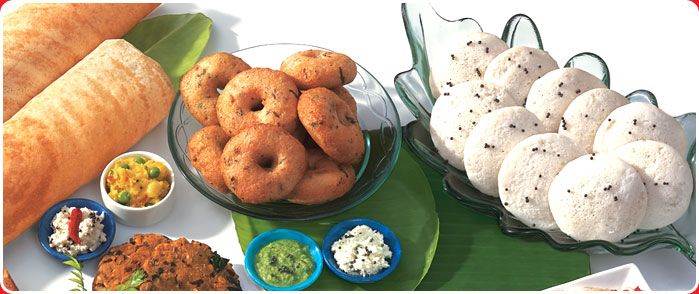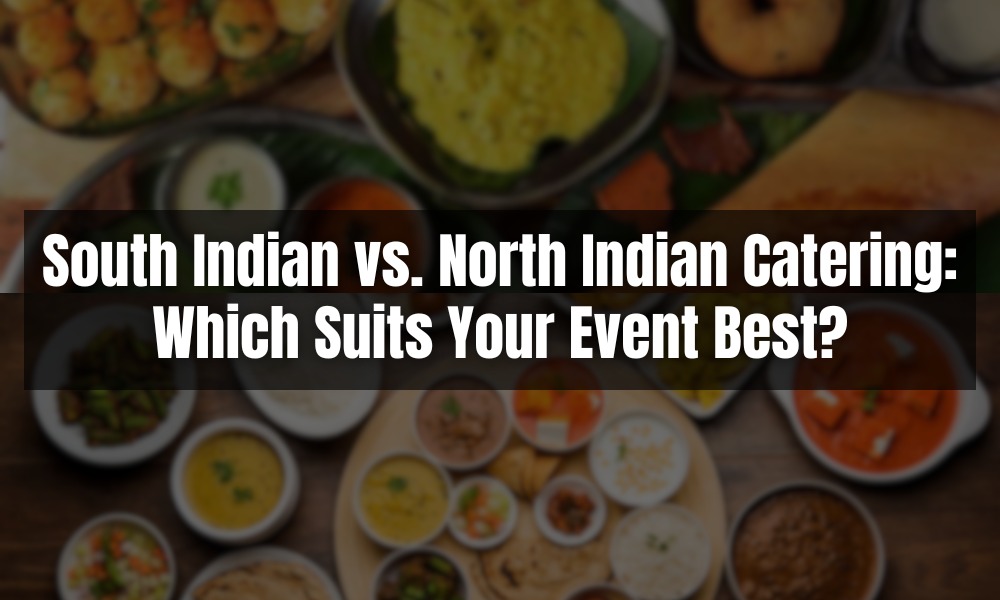Planning a big event? One of the most important parts is deciding the food menu. As experienced caterers, we know food can make or break your event. When it comes to Indian cuisine, two styles always stand out—South Indian and North Indian catering. But which one is right for your special occasion?
In this blog, we’ll help you understand the differences, highlight the specialties of each cuisine, and guide you in choosing the best fit for your event.
Understanding the Basics: South Indian vs. North Indian Cuisine
Both South Indian and North Indian cuisines are rich in flavor, tradition, and variety. However, they differ in ingredients, cooking styles, and presentation.
South Indian Cuisine:
- Known for its rice-based dishes, lentils, and coconut.
- Light, spicy, and often served on banana leaves.
- Popular dishes include idli, dosa, vada, sambar, rasam, curd rice, and various chutneys.
- Most dishes are vegetarian-friendly, making it ideal for traditional ceremonies and pure veg functions.

North Indian Cuisine:
- Features wheat-based dishes like roti, naan, and parathas.
- Rich, creamy gravies with paneer, vegetables, or meat.
- Popular items include butter chicken, dal makhani, chole, rajma, biryani, and kheer.
- Perfect for events where guests expect a hearty, filling meal.

Choosing Based on the Event Type
Let’s break it down by different types of events:
1. Weddings & Traditional Ceremonies
If you are hosting a South Indian wedding, especially in Tamil, Telugu, Kannada, or Malayali culture, a South Indian menu with banana leaf serving is preferred. Guests expect authentic traditional flavors like sambar, rasam, poriyal, avial, and sweet pongal.
For North Indian weddings, especially Punjabi, Marwari, or UP-style, a grand buffet with multi-course North Indian dishes is the norm. Think chaat counters, paneer tikka, kebabs, butter naan, dal makhani, and jalebi-rabdi.
2. Corporate Events
For corporate lunches or formal events, South Indian meals are often appreciated for being light and easy to digest. A simple menu of lemon rice, curd rice, vegetable biryani, or dosa stations works well.
However, for evening corporate dinners or high-end gatherings, a North Indian buffet adds a sense of richness and variety. Live roti counters, biryani stalls, and dessert bars are great crowd-pleasers.

3. Birthdays and Small Family Gatherings
For smaller gatherings, South Indian tiffin-style catering with mini idlis, upma, pongal, and sweets like kesari or payasam is cost-effective and comforting.
On the other hand, North Indian snacks like samosas, pav bhaji, paneer rolls, or chaat add a festive mood to birthday parties.

Taste Preferences of Guests
Knowing your guests’ preferences is key.
- If your guests prefer light, flavorful meals with simple ingredients and less oil, South Indian catering is the way to go.
- If they enjoy rich flavors, creamy textures, and a wide range of vegetarian and non-veg options, North Indian food will satisfy them.
Also, South Indian food suits hot and humid climates better, while North Indian food is preferred during colder seasons or in AC banquet settings.
Presentation & Serving Styles
South Indian catering offers a traditional touch when served on banana leaves. It’s ideal for temples, religious functions, and homely events. Guests love the authentic vibe and eco-friendliness of this style.
North Indian catering usually involves buffet counters with modern setups. It suits hotels, banquet halls, and outdoor events. With options like live tandoor stations or dessert counters, it adds a sense of celebration and grandeur.

South Indian Menu Ideas:
- Welcome drink: Buttermilk or Panakam
- Starters: Medu Vada, Mini Idli with Podi
- Main Course: Sambar, Rasam, Poriyal, Avial, Curd Rice
- Sides: Coconut Chutney, Pickles, Papadam
- Dessert: Payasam, Kesari, Mysore Pak
North Indian Menu Ideas:
- Welcome drink: Jaljeera or Lassi
- Starters: Paneer Tikka, Veg Kebabs, Chaat Counter
- Main Course: Dal Makhani, Shahi Paneer, Mixed Veg, Biryani, Naan, Roti
- Sides: Salad, Pickle, Raita
- Dessert: Gulab Jamun, Jalebi, Kheer
So, Which One Should You Choose?
At the end of the day, both cuisines are delicious. The best one for your event depends on:
- Type of event
- Cultural background
- Guest preferences
- Venue setup
- Time of the event
You can also consider mixing both styles for a balanced menu that appeals to everyone. For example, start with South Indian snacks and end with a North Indian dinner. Or have separate food counters for each cuisine.
As professional caterers, we can help you customize your menu as per your needs. Whether it’s an all-vegetarian South Indian thali or a royal North Indian feast, we ensure your guests enjoy every bite!
Conclusion
Food creates memories. Choosing the right catering style will leave a lasting impression on your guests. So, take time to plan your menu, keep your guests in mind, and let us handle the rest.
Still confused? Contact Satish Caterers, and we’ll help you plan a food experience your guests will talk about long after the event ends. With over 60 years of expertise in both South Indian and North Indian catering, we make every occasion special with authentic flavors and warm hospitality.




